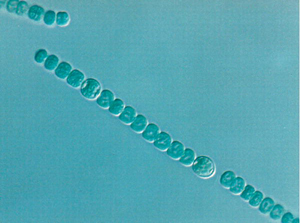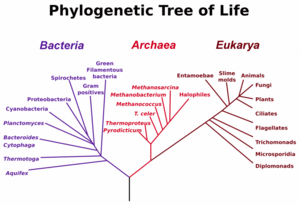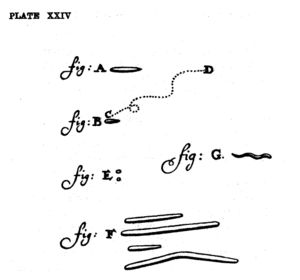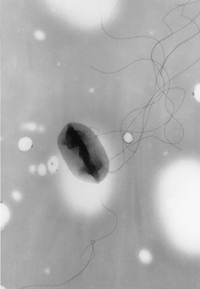Microorganism

Microorganism is the scientific word for "germs" and the other life forms that are too small to be seen individually with the naked eye. Some microorganism were known before the invention of the microscope because, like the phosphorescent plankton of the seas and the green fuzz of mold on bread, they could be perceived in swarms or groups. But, since most microrganisms do not exist in such obvious colonies, their presence as individual life forms has only been appreciated since the 17th century. Even now, since special knowledge, techniques, and instruments are required to recognize them, the concept of microscopic life and an appreciation for the importance of these organisms in the health and ecology of all living things is not universal.
How important are microorganisms? Everywhere humans can venture on our planet, and in many places where we cannot ever go, microorganisms are present. The fertility of the soil, the proper digestion of foodstuffs by vertebrates, the ability for dead plants and animals to decay and recycle, the rising of bread and the fermentation of beer, are all dependent upon the existence of microscopic life.
Many people automatically assume germs are bad, because they cause infectious disease, but most germs (or microbes, as they are also called) do not cause disease, but promote health. Both the workings of the living world and the grand biological cycles of matter on earth, and human survival, are intimately dependent on the diverse chemical activities of microbes. The outer surface of animals and plants, and the lining of much of the digestive tract of animals, is completely covered by colonized microorganism that create an environment that is required for the healthy function of these living surfaces.
All other life descended from microbes. Current investigations of microbes are revealing clues about the earliest stages in evolution of life on earth stretching nearly 4 billion years ago. Because of the ease with which large numbers of them can be grown, microbes are important for teaching us about genetics - the science of inheritance. Study of inheritance of traits in microbes has enable biologists to work out the intricate details of inheritance in most living cells, and led to discovery that DNA is the chemical through which inheritable traits are passed from generation to generation. The short generation time of certain bacteria, along with a high mutation rate, has provided the first laboratory proofs of the theory of natural selection and evolution.
The investigation of microbes and their genetic behavior has been fundamental in the flowering of the biological sciences that occured during last century, starting in the mid-1940s.
Germs include both microbial cells and viruses
The drawing made more that three hundred years ago by Anthonie van Leeuwenhoek of the observation made with the first microscope shows what typical common microbes look like, in this cast mouth bacteria look like. relatively little detail is seen even with modern light microscope, but minute rods (about 1 micron long, or similar sised spirals, and sperical cells called cocci, singular coccus) are typical of common bacteria. The diagram show Leeuwenhoek's depiction of bacterial motility.
Microbes are organisms that are microscopic (too small to be visible to the naked eye). Micro-organisms are often considered to be single-celled, or unicellular organisms, but many are multi-cellular, and many multicellular species of plants and animals are microscopic. Microbes also include organisms that are even too minute (less that 300 nm in diameter) to seen even with a light microscope, that do not have a typical cellular form of structural organisation - that is the viruses.
Microorganisms include bacteria, bacteria-like organisms now called Archaea, protists, many fungi, and the non-cellular viruses, which themselves comprise a diverse range of agents all of which depend on the metabolism and protein synthesis capabilities of cellular organisms to reproduce.
Some unicellular protists and unusually large bacteria (Epulopiscium fishelsoni and Thiomargarita namibiensis) are visible to the naked eye [1], and many multicellular species of plants and animals are microscopic.
The study of micro-organisms is called microbiology.
Importance
Microorganisms are vital to humans and the environment, as they participate in the Earth's element cycles such as the carbon cycle and nitrogen cycle, as well as fulfilling other vital roles in virtually all ecosystems, such as recycling other organisms' dead remains and waste products through decomposition. Microbes also have an important place in most higher-order multicellular organisms as symbionts, and important organelles of cells, the plastids (chloroplasts) and mitochondria are the result of endosymbiosis of microbes within eukaryotic cells. Many blame the failure of Biosphere 2 on an improper balance of microbes.
Habitats and ecology
Microorganisms are found in virtually every habitat present in nature. Even in hostile environments such as the poles, deserts, geysers, rocks, and the deep sea, some types of microorganisms have adapted to the extreme conditions and sustained colonies; these organisms are known as extremophiles. Some extremophiles have been known to survive for a prolonged time in a vacuum, and some are unusually resistant to radiation. Many types of microorganisms have intimate symbiotic relationships with other larger organisms; some of which are mutually beneficial (mutualism), while others can be damaging to the host organism (parasitism). If microorganisms can cause disease in a host they are known as pathogens.
Extremophiles
Certain microbes have adapted so that they can survive and even thrive in conditions that are normally fatal to most lifeforms. Microorganisms have been found around underwater black smokers and in geothermal hot springs, as well as in extremely salty bodies of water.
Use in food
Microorganisms are used in brewing, baking and other food-making processes. The lactobacilli and yeasts in sourdough bread are especially useful. To make bread, one uses a small amount (20-25%) of "starter" dough which has the yeast culture, and mixes it with flour and water. Some of this resulting dough is then saved to be used as the starter for subsequent batches. The culture can be kept at room temperature and continue yielding bread for years as long as it remains supplied with new flour and water. This technique was often used "on the trail" in the American Old West. Microorganisms are also used to control fermentation in the production of cultured dairy products such as yogurt and cheese. The cultures also provide flavour and aroma, and to inhibit undesirable organisms.[2]
Use in science
Microbes are also essential tools in biotechnology, biochemistry, genetics and molecular biology. One of the main reasons that microbes - such as Escherichia coli bacteria and yeast - are important tools is that they are easy to grow and large numbers of them can be studied which makes for rapid progress in genetics investigation. Starting with the work of George Beadle, Edward Tatum, and Joshua Lederberg they played a major part in the rapid advances in biochemistry and genetics between 1945 to 1960. Bacterial viruses - bacteriophages, or just phages - contributed to the growth of molecular biology, pioneered by biologists such as Max Delbruck, Seymour Benzer and Sydney Brenner. Around 1975 with introduction of gene cloning based on plasmids and restriction endonucleases, microbes gave further impetus to the science of molecuar biology, genomics, and biotechnology, and continue to be work-horse tools in many laboratories world wide.
Microorganisms and human health
Microbes in human digestion
Microorganisms can form an endosymbiotic relationship with other, larger, organisms. For example, the human digestive system depends on bacteria that live inside the intestines to help break down food.
Diseases and immunology
Microorganisms are the cause of many infectious diseases. The organisms involved include bacteria, causing diseases such as plague, tuberculosis and anthrax: protozoa, causing diseases such as malaria, sleeping sickness and toxoplasmosis; and also fungi causing diseases such as ringworm, candidiasis or histoplasmosis. However, other diseases such as influenza, yellow fever or AIDS are caused by viruses, which are not living organisms and are not therefore microorganisms.
Immunology is the study of human animal responses to infection and cancer. It is a major field af medical science allied to medical microbiology.
Hygiene
Hygiene is the avoidance of infection or food spoiling by eliminating microorganisms from the surroundings. As microorganisms, particularly bacteria, are found practically everywhere, this means in most cases the reduction of harmful microorganisms to acceptable levels. However, in some cases it is required that an object or substance is completely sterile, i.e. devoid of all living entities and viruses. A good example of this is a hypodermic needle. In food preparation, microorganisms are reduced by preservation methods (such as the addition of vinegar), clean utensils used in preparation, short storage periods or by cool temperatures. If complete sterility is needed, the two most common methods are irradiation and the use of an autoclave, which resembles a pressure cooker.
There are several methods for investigating the level of hygiene in a sample of food, drinking water, equipment etc. Water samples can be filtrated through an extremely fine filter. This filter is then placed in a nutrient medium. Microorganisms on the filter then grow to form a visible colony. Harmful microorganisms can be detected in food by placing a sample in a nutrient broth designed to enrich the organisms in question. Various methods, such as selective media or PCR, can then be used for detection. The hygiene of hard surfaces, such as cooking pots, can be tested by touching them with a solid piece of nutrient medium and then allowing the microorganisms to grow on it.
There are no conditions where all microorganisms would grow, and therefore often several different methods are needed. For example, a food sample might be analysed on three different nutrient mediums designed to indicate the presence of "total" bacteria (conditions where many, but not all, bacteria grow), molds (conditions where the growth of bacteria is prevented by e.g. antibiotics) and coliform bacteria (these indicate a sewage contamination).
History
Evolution
Single-celled microorganisms were the first forms of life to develop on earth, approximately 4 billion years ago. For about 3 billion years, all life was microscopic, and many of the same biological and chemical processes that these microorganisms developed are used today in higher order organisms as well as microbes [3]. Most microorganisms reproduce rapidly and in great number. This, coupled with a high mutation rate and many other means of genetic variation, allows microorganisms to swiftly evolve (via natural selection) to survive in new environments . This has led, notably, to the recent development of 'super-bugs' - pathogenic bacteria that are resistant to modern antibiotics. Another notorious example of this is HIV, which has evolved an immunity to all drugs used against it so far, although as a virus, it is not, according to some definitions, a microorganism.
Discovery
Before Anton van Leeuwenhoek's invention of the microscope and discovery of microorganisms with it in 1676, it had been a mystery as to why grapes could be turned into wine, milk into cheese, or why food would spoil. Leeuwenhoek did not make the connection between these processes and microorganisms, but he did establish that there were forms of life that were not visible to the naked eye. Leeuwenhoek's discovery, along with subsequent observations by Lazzaro Spallanzani and Louis Pasteur, ended the long-held belief that life could spontaneously appear from non-living substances.
Spallanzani found that microorganisms could only settle in a broth if the broth was exposed to the air; he also found that boiling the broth would sterilise it, killing the microorganisms. Pasteur expanded upon these findings by exposing boiled broths to the air in vessels that contained a filter to prevent all particles from entering, or in vessels with no filter but with air being admitted via a curved tube that would not allow dust particles to come into contact with the broth. By first boiling the broth, Pasteur ensured that there were no microorganisms alive in the broths at the start of his experiment. Nothing grew in the broths during his experiments, showing that the living organisms that grew in such broths came from outside, as spores on dust, rather than spontaneously generated within the broth. Thus, Pasteur decisively refuted the theory of spontaneous generation and supported germ theory.
In 1876, Robert Koch showed that microbes can cause disease, by showing that the blood of cattle that were infected with anthrax always contained large numbers of Bacillus anthracis. Koch also found that he could transmit anthrax from one animal to another by taking a small sample of blood from the infected animal and injecting it into a healthy one, causing the healthy animal to become sick. He also found that he could grow the bacteria in a nutrient broth, inject it into a healthy animal, and cause illness. Based upon these experiments, he devised criteria for establishing a causal link between a microbe and a disease in what are now known as Koch's postulates. Though these postulates are no longer strictly accurate, they remain historically important in the development of scientific thought.

Classification
Microorganisms can be found in almost all branches of the taxonomic organization of life on the planet. Bacteria and archaea are almost always microscopic, whilst a number of eukaryotes are also microscopic, including most protists and a number of fungi. Increasingly, the practical identification and classification of micro-organisms is being based on the genetic code, that is, the nucleotide sequence of the RNA in the small ribosome subunit [4] . Viruses are generally regarded as not living in the same sense as other organisms and are, strictly speaking, not microbes, although the field of microbiology also encompasses the study of viruses.
Bacteria
Bacteria, sometimes called eubacteria (true bacteria) to distinguish them from Archaea (formerly called archeobacteria) are structurally the simplest and biochemically the most diverse and widespread organisms on Earth. Generally they consist of simple rod-like or spherical (coccus, pl. cocci) cells about 1 micron in size without a defined nucleus (and are thus classified as prokaryotes but also classified as Monera in the alternative five-kingdom taxonomy) (see Bacterial cell structure}.
Bacteria are practically all invisible to the naked eye, with few extremely rare exceptions, such as Thiomargarita namibiensis. They are unicellular organisms and lack organelles. Their genome is a single string of DNA, although they can also harbour small pieces of DNA called plasmids. Bacteria are surrounded by a cell wall. They reproduce by binary fission. Some species form spores, but for bacteria this is a mechanism for survival, not reproduction. Their generation time can be as short as 15 minutes.
Bacteria inhabit practically all environments where some liquid water is available and the temperature is below +140 °C. They are found in sea water, soil, human gut, hot springs and in food. Practically all surfaces which have not been specially sterilised are covered in bacteria. The number of bacteria in the world is estimated to be around five million trillion trillion, or 5 × 1030.[5]
Archaea
Archaea are single-celled organisms lacking defined nuclei and are therefore prokaryotes. They were originally identified in extreme environments, but have since been found in diverse types of habitats. A single organism from this domain has been called an 'archaean'. Although archaea are superficially similar to bacteria when viewed through the light microscope, consisting of rods or cocci a micron or two in size, the details of their chemistry and molecular structure show they have distinct differences from bacteria, for instance in their membrane fats which employ a different stereo isomer of glycerol phosphate in the membrane fat, are ether rather than ester derivatives of glycerol (glycerol di-ethers and tetra-ethers), and based on the isoprenes to form the hydrophobic chain of the fats. These fundamental differences in biochemistry fit with the concept that Archaea and Bacteria diverged in evolution very early in the history of life [6].
Eukaryotes
All living things, including humans, which are individually visible to the naked eye are eukaryotes, with some exceptions, such as Thiomargarita namibiensis. However, many eukaryotes are also microorganisms. Eukaryotes are characterised by the presence of organelles in the cells; these structures are absent in bacteria and archaea. The nucleus is an organelle which houses the DNA.[7] A mitochondrion is vital in production and conversion of energy inside a cell. The mitochondr]] have evolved from symbiotic bacteria. Plant cells also have cell walls and chloroplasts in addition to other organelles. Chloroplasts produce energy from light by photosynthesis. They were also originally symbiotic bacteria.
Unicellular eukaryotes consist of a single cell throughout their life cycle (note that most multicellular eukaryotes consist of a single cell at the beginning of their life cycles). Unicellular organisms usually contain only a single copy of their genome when not undergoing cell division, although some organisms have multiple cell nuclei (see coenocyte). However, not all microorganisms are unicellular. Microbial eukaryotes can have multiple cells.
Of the eukaryotic groups, the protists are always unicellular, and thus microorganisms. This is a diverse group of organisms which do not fit into other groups of eukaryotes. Several algae species are unicellular plants. The fungi also have several unicellular species, such as baker's yeast (Saccharomyces cerevisiae). Animals are always multicellular, although they may not be visible to the naked eye.
Microorganisms in fiction
Microorganisms have frequently played an important part in science fiction, both as agents of disease, and as entities in their own right. Some notable uses of microorganisms in fiction include:
- The War of the Worlds, where microorganisms play important thematic and plot-related roles.
- Fantastic Voyage, in which some scientists are miniaturised to microscopic size and observe microorganisms from a new perspective
- Blood Music, in which a colony of microorganisms is given intelligence
- The Andromeda Strain, in which extraterrestrial microorganisms kill several people
References
Citations
- ↑ Annu Rev Microbiol. 2001;55:105-37. Big bacteria. Schulz HN, Jorgensen BB.
- ↑ Dairy Microbiology. University of Guelph. Retrieved on 2006-10-09.
- ↑ Knoll, Andrew H.; (2003). Life on a Young Planet: the First Three Billion Years of Evolution on Earth, 1st ed.. Princeton University Press. ISBN 0-691-00978-3.
- ↑ Ribosomal Database Project II
- ↑ University of Georgia Campus News
- ↑ Pace Norman R. (2001) The universal nature of biochemistry PNAS vol. 98 no. 3 p 805-808
- ↑ "Eukaryota: More on Morphology." [1] (Accessed 10 October 2006)
Further reading
- Dixon, Bernard (1994). Power Unseen: How Microbes Rule the World, 1st ed.. W. H. Freeman, Oxford and New York. ISBN 0-7167-4504-6.
- Krasner, Robert I. (2002). The Microbial Challenge: Human-Microbe Interactions, 1st.. ASM Press, Washington, DC. ISBN 0-13-144329-4.
- Knoll, Andrew H. (2003). Life on a Young Planet: the First Three Billion Years of Evolution on Earth, 1st ed.. Princeton University Press. ISBN 0-691-00978-3.
- Postgate, John (1992). Microbes and Man, 3rd ed.. Cambridge University Press, UK. ISBN 0-521-42355-4.
External links
Microbes and toxins important in food
US Food & Drug Administration Food Safety's "Bad Bug Book" [2]

